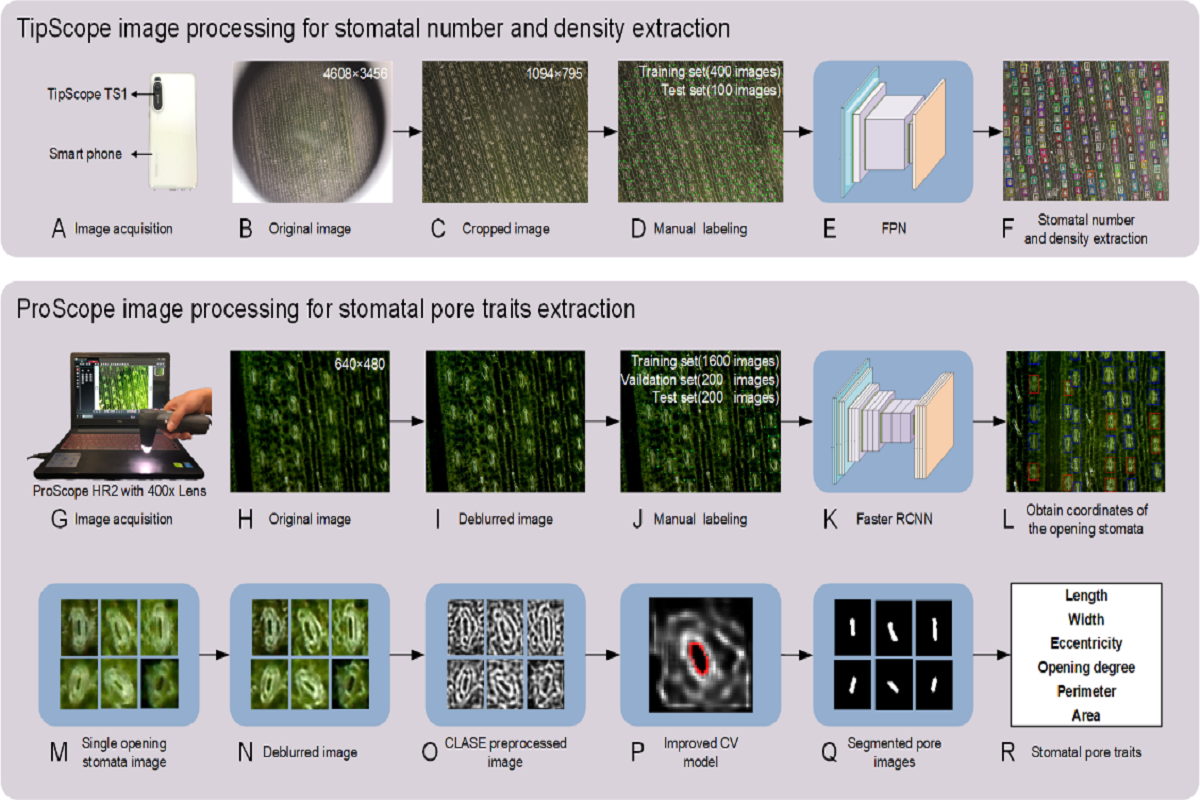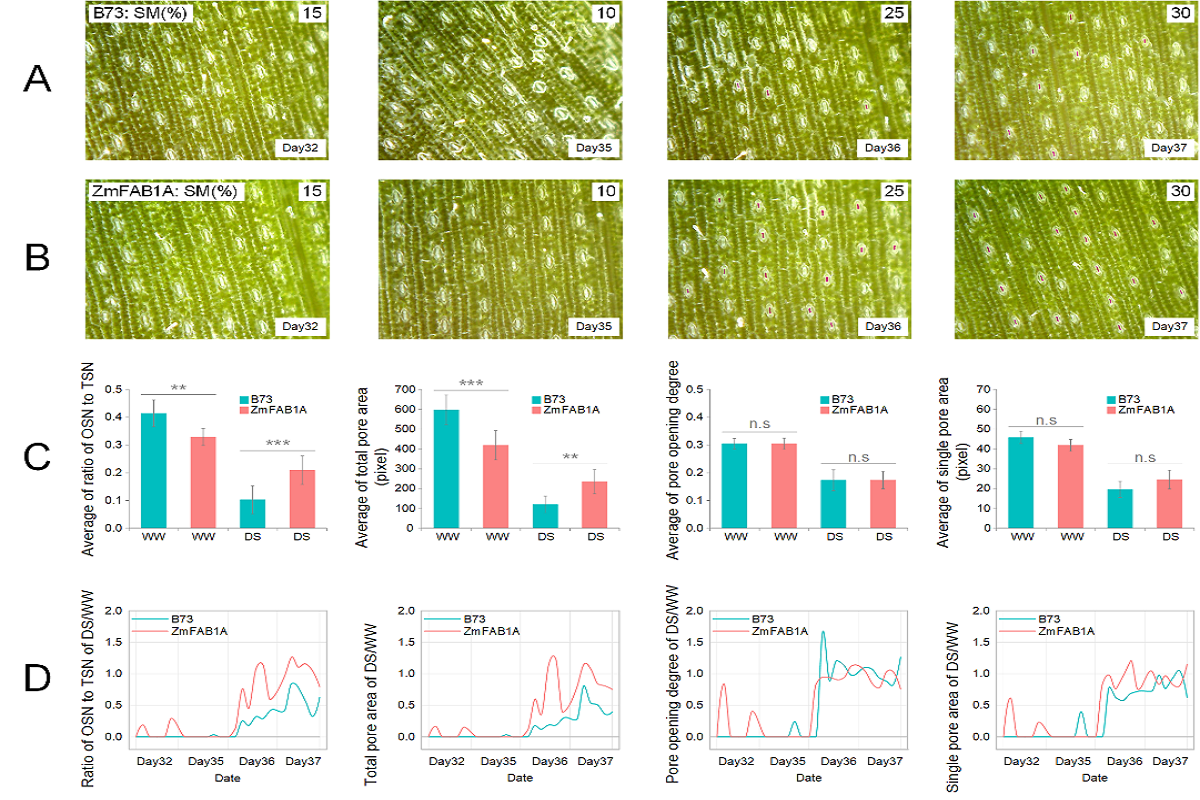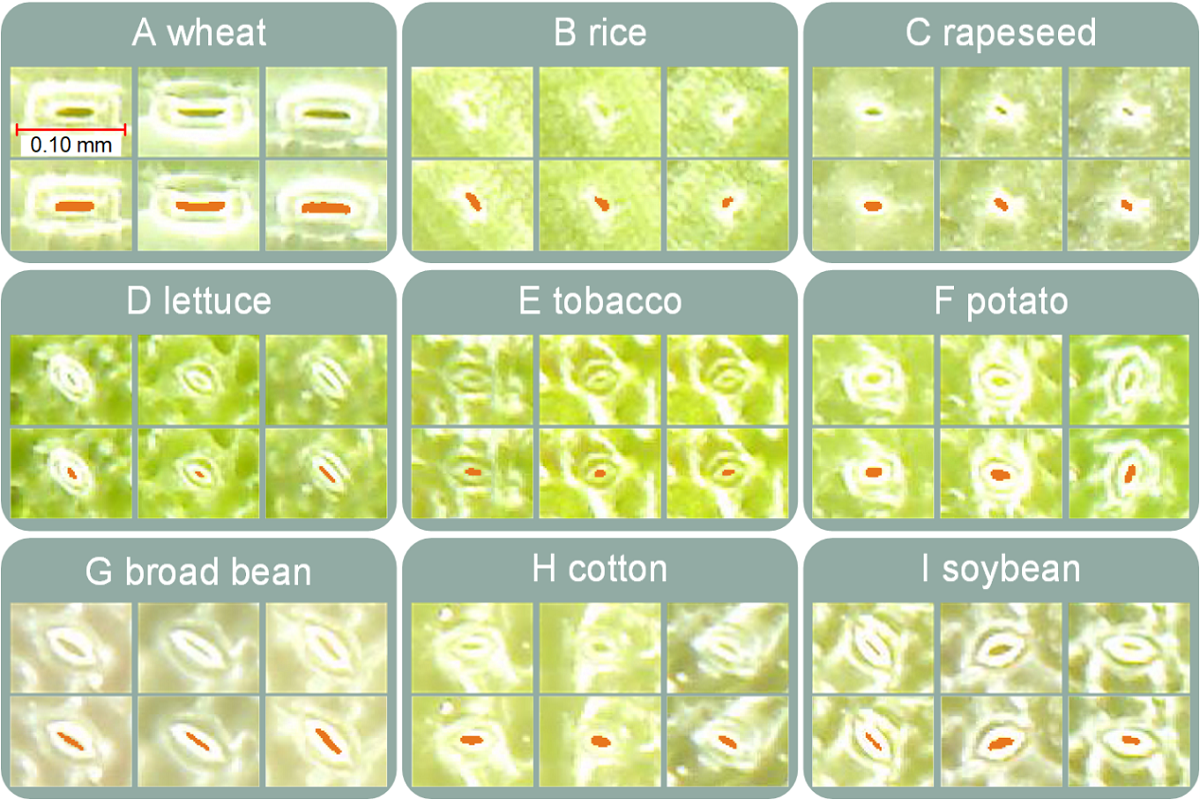南湖新闻网讯(通讯员 梁秀英)近日,我校作物遗传改良国家重点实验室作物表型团队杨万能教授课题组研发了一种叶片气孔表型测量新技术,并对不同玉米材料干旱胁迫下的气孔性状差异及其潜在应用价值进行了深入研究,为解决作物叶片气孔表型高通量检测和遗传机制解析提供技术支撑。
叶片气孔由特化的表皮细胞形成,是植物内部和外部环境之间气体交换的主要通道,气孔在作物生长过程中对碳和水循环的调节起着重要作用,并影响植株的蒸腾强度和光合作用。叶片气孔运动是一个复杂的调控过程,受到植物内外部多重因素的影响,目前大部分的叶片气孔研究手段为有损检测,尚没有一套成熟的活体叶片气孔研究体系。

图1 叶片气孔表型提取和分析流程
本研究利用两种不同分辨率的便携式显微成像仪(TipScope和ProScope HR2)获取玉米活体叶片气孔显微图像,图像分辨率分别为(TipScope,4608×3456 pixels,~6 μm/pixel)和 (ProScope HR2,640×480 pixel,~1.5 μm/pixel)。基于TipScope提取低分辨率的气孔图像,研发FPN深度学习模型提取和分析气孔数量和气孔密度;基于ProScope HR2提取的高分辨率气孔图像,研发RCNN模型区分打开气孔和闭合气孔,并计算开闭气孔数量。对于打开气孔,提出一种改进的基于Chan-Vese(CV)模型的分割方法分割气孔,进而提取气孔长、气孔宽、偏心率、气孔开度、气孔面积、气孔周长总计6个气孔性状。实验结果表明,和真实值比较,本技术气孔表型检测精度R2在0.85-0.99,平均相对误差在0.1%-6.34%之间,证明本技术检测的准确性。在检测效率方面,本技术无需对样本进行预处理,处理500张TipScope图像耗时约42秒,ProScope HR2获取一幅图像的时间约为5~10s,处理500张ProScope图像耗时约40分钟。总体来说,提取每个叶片所有气孔特征的总时间约为10~15s。

图2 野生型B73和突变体Zmfab1a在充足水分(WW)和干旱胁迫(DS)条件下的气孔动态响应
为了验证该方法提取的气孔性状的有效性,团队进一步探索了B73玉米野生型和 Zmfab1a突变体在在正常浇水和干旱胁迫条件下的气孔表型差异。研究表明,在干旱复水后,Zmfab1a的气孔打开数量和气孔平均面积均高于B73,说明突变体Zmfab1a叶片气孔干旱响应和恢复能力高于B73,具有更好的抗旱性。
为了进一步评估基于改进CV模型的气孔分割方法的可行性,本研究还测试小麦、水稻、油菜、莴苣、烟草、马铃薯、蚕豆、棉花和大豆其他9种植物,实验结果表明本技术是可以成功推广到其他作物叶片气孔表型检测。

图3 不同作物的叶片气孔分割结果
综上所述,本研究提出了一种便携式、低成本(约1000美元)、高通量(约15秒/叶片)的叶片气孔表型动态提取和分析方法,并建立门户网站供全球用户开放使用,促进未来大群体作物叶片气孔表型动态研究和遗传机制解析。
该成果以“StomataScorer: A portable and high-throughput leaf stomata trait scorer combined with deep learning and an improved CV model”为题发表在《Plant Biotechnology Journal》。华中农业大学工学院梁秀英老师和许锡晨硕士生为论文的共同第一作者,杨万能教授为通讯作者。本研究得到了国家重点研究发展计划、国家自然科学基金、湖北省科技重大专项和中央高校基础研究基金的资助。
审核人:杨万能
【英文摘要】
To measure stomatal traits automatically and nondestructively, a new method for detecting stomata and extracting stomatal traits was proposed. Two portable microscopes with different resolutions (TipScope with a 40x lens attached to a smartphone and ProScope HR2 with a 400x lens) are used to acquire images of living stomata in maize leaves. FPN model was used to detect stomata in the TipScope images and measure the stomata number and stomatal density. Faster RCNN model was used to detect opening and closing stomata in the ProScope HR2 images and the number of opening and closing stomata were measured. An improved CV-model was used to segment pores of opening stomata and a total of 6 pore traits were measured. Compared to manual measurements, the square of the correlation coefficient (R2) of the 6 pore traits was higher than 0.85, and the mean absolute percentage error (MAPE) of these traits was 0.02%~6.34%. The dynamic stomata changes between wild type B73 and mutant Zmfab1a were explored under drought and re-watering condition. The results showed that Zmfab1a had a higher resilience than B73 on leaf stomata. In addition, the proposed method was tested to measure the leaf stomatal traits of other 9 species. In conclusion, a portable and low-cost stomata phenotyping method that could accurately and dynamically measure the characteristic parameters of living stomata was developed. An open-access and user-friendly web portal was also developed which has the potential to be used in the stomata phenotyping of large populations in the future.

